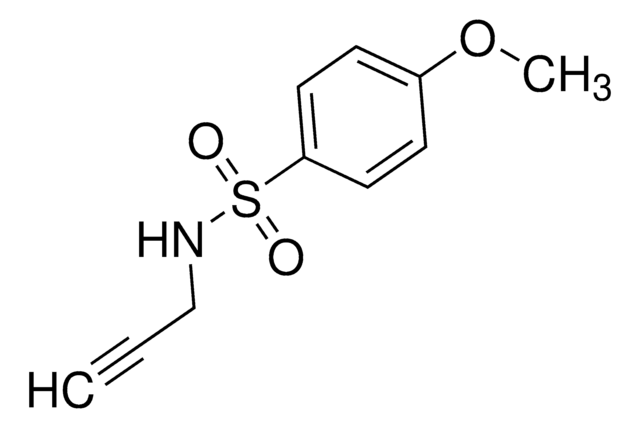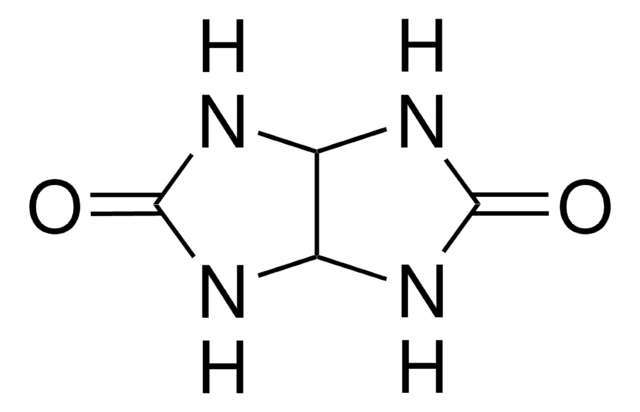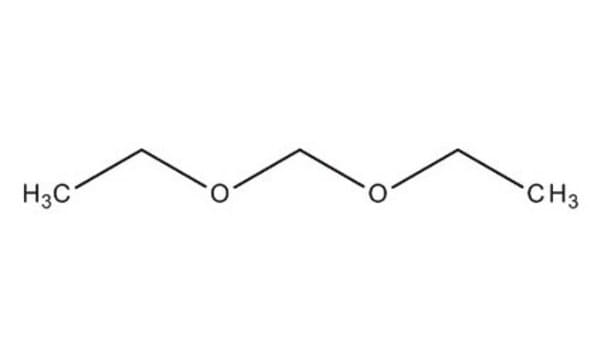D134651
Dimethoxymethane
ReagentPlus®, 99%
Synonim(y):
Formaldehyde dimethyl acetal, Methylal
Zaloguj sięWyświetlanie cen organizacyjnych i kontraktowych
About This Item
Wzór liniowy:
CH2(OCH3)2
Numer CAS:
Masa cząsteczkowa:
76.09
Beilstein:
1697025
Numer WE:
Numer MDL:
Kod UNSPSC:
12352100
Identyfikator substancji w PubChem:
NACRES:
NA.21
Polecane produkty
gęstość pary
2.6 (vs air)
Poziom jakości
ciśnienie pary
6.38 psi ( 20 °C)
linia produktu
ReagentPlus®
Próba
99%
Postać
liquid
temp. samozapłonu
459 °F
granice wybuchowości
17.6 %
współczynnik refrakcji
n20/D 1.354 (lit.)
tw
41-42 °C (lit.)
mp
−105 °C (lit.)
gęstość
0.86 g/mL at 25 °C (lit.)
ciąg SMILES
COCOC
InChI
1S/C3H8O2/c1-4-3-5-2/h3H2,1-2H3
Klucz InChI
NKDDWNXOKDWJAK-UHFFFAOYSA-N
Powiązane kategorie
Opis ogólny
Dimethoxymethane (DMM, methylal) is a biodegradable dimethyl acetal. It can be synthesized by acid catalyzed condensation of formaldehyde with methanol. It is amphiphilic in nature with low viscosity, surface tension and boiling point. It is a flammable, highly volatile solvent with good dissolving power. DMM is considered as a potential alternative fuel and fuel additive due to its high oxygen content and its ability to enhance the combustion characteristics of diesel and petrol. Its thermal diffusivity has been determined by photoacoustic method. Analysis of the molecular structure of DMM by electron diffraction technique shows that it has C2 symmetry with a gauche-gauche conformation.
Zastosowanie
Dimethoxymethane (Formaldehyde dimethyl acetal) may be used in the synthesis of methoxymethyl (MOM) ethers. It may also be used as an external cross-linker to form microporous polymers.
Informacje prawne
ReagentPlus is a registered trademark of Merck KGaA, Darmstadt, Germany
This page may contain text that has been machine translated.
Hasło ostrzegawcze
Danger
Zwroty wskazujące rodzaj zagrożenia
Zwroty wskazujące środki ostrożności
Klasyfikacja zagrożeń
Flam. Liq. 2
Zagrożenia dodatkowe
Kod klasy składowania
3 - Flammable liquids
Klasa zagrożenia wodnego (WGK)
WGK 1
Temperatura zapłonu (°F)
-0.4 °F - closed cup
Temperatura zapłonu (°C)
-18 °C - closed cup
Środki ochrony indywidualnej
Eyeshields, Faceshields, Gloves
Choose from one of the most recent versions:
Masz już ten produkt?
Dokumenty związane z niedawno zakupionymi produktami zostały zamieszczone w Bibliotece dokumentów.
Klienci oglądali również te produkty
The molecular structure of dimethoxymethane.
Astrup EE.
Acta Chemica Scandinavica, 27(9), 3271-3276 (1973)
A photoacoustic study on Dimethoxymethane.
Bama GK and Ramachandran K.
AIP Conference Proceedings, 1004, 191-191 (2008)
A new strategy to microporous polymers: knitting rigid aromatic building blocks by external cross-linker.
Li B, et al.
Macromolecules, 44(8), 2410-2414 (2011)
An efficient protocol for the preparation of MOM ethers and their deprotection using zirconium (IV) chloride.
Sharma GVM, et al.
Tetrahedron Letters, 45(50), 9229-9232 (2004)
Jenn-Huei Lii et al.
Carbohydrate research, 340(5), 853-862 (2005-03-23)
The rotational barrier for a methyl group at the end of an anomeric system is sometimes lower than we might have anticipated. Thus, in the trans-trans conformation of dimethoxymethane, the barrier to methyl rotation is calculated (B3LYP/6-311++G(2d,2p)) to be 2.22
Nasz zespół naukowców ma doświadczenie we wszystkich obszarach badań, w tym w naukach przyrodniczych, materiałoznawstwie, syntezie chemicznej, chromatografii, analityce i wielu innych dziedzinach.
Skontaktuj się z zespołem ds. pomocy technicznej











